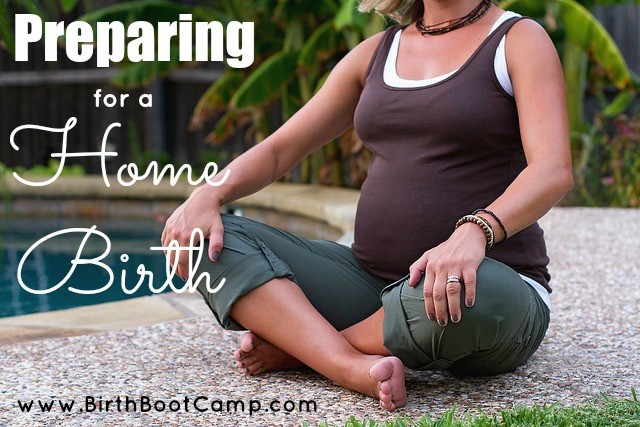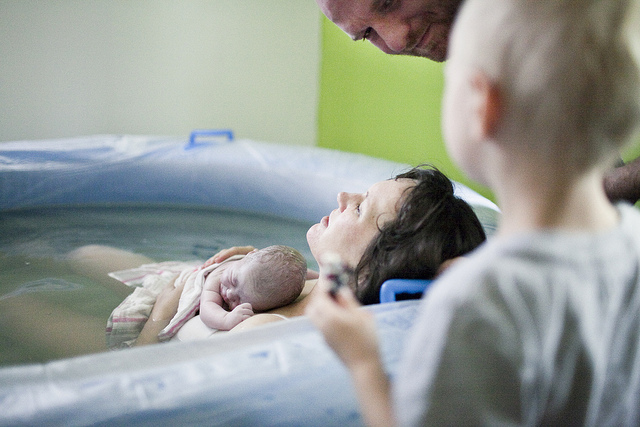In the first part of this article we analyzed three important issues related to home birth: personal satisfaction, the mother’s safety and the baby’s risks. Check out the next three reasons women choose a home birth…
4) “I plan to have a home birth, but if something should happen I will go to a hospital”
 Even when properly prepared for a home birth, transfer to a hospital is commonly required
Even when properly prepared for a home birth, transfer to a hospital is commonly required
As previously mentioned, hospital transportation is a common event: about 1 out of 2 first time mothers and 2 out of 10 second or subsequent time mothers need to be transferred to a hospital; moreover, hospital transfer is almost always perceived by the couple as a negative and disruptive experience (see part 1).
The need for transportation to a hospital can occur before, during of after birth, and can be related to the mother, the baby or both. The top reasons may vary in different countries, although prolonged labour is the first cause of transfer in almost every study, followed by pain relief or the midwife’s unavailability at the onset of labor.
In the UK, the most common reasons for transfer are:
- Prolonged labour (32.4%)
- Meconium staining (12.2%)
- Repair of a perineal tear (10.9%)
- Abnormal fetal heart rate (7.0%)
- Retained placenta (7.0%)
- Request for regional analgesia (epidural, spinal) (5.1%)
- Neonatal concerns (postpartum) (5.1%)
- Others (20.1%)

Home birth activist Caroline Lovell died of complications after giving birth her second child at home. Her death was preventable, justice says.
Other reasons include:
–During labor: maternal fever, fetal malpresentation, shoulder dystocia (baby’s shoulders getting stuck inside the mother), cord prolapse, uterine rupture, acute bleeding, placental abruption, vasa previa, acute sepsis.
–After birth: tears of the vagina or cervix, sphincter rupture, uterine atony, placenta accreta, increta, or percreta.
–Baby-related (post partum): unexpected very low or very high birthweight, neonatal depression, signs of respiratory distress, unexpected malformations, acute sepsis.
These are some important facts to keep in mind:
- Maternal and fetal necessity for transport is often impossible to predict.
- For unpredictable, extremely sudden complications, even rapid transport may not prevent the baby or the woman from death or severe harm, such as shoulder dystocia, sudden cardiopulmonary arrest, or maternal exsaguination (bleeding to death, read Caroline Lovell story here).
- Women with severe hemorrhage may already be in shock when arriving at a hospital. Even though the adequate treatment can be immediately instituted, death may nevertheless occur.
- Perinatal mortality is higher when transport to the hospital is required.
5) “At home I can have a water birth”
 The latest years there has been an increasing demand for water birth
The latest years there has been an increasing demand for water birth
Immersion in water during labor and delivery, although available for several decades, has seen a greatly renewed interest the latest years. In fact, even certain hospitals and birth centers have incorporated birth pools to their facilities. The results of studies analyzing maternal and fetal benefits and risks of water birth are inconsistent, and many times contradictory. The American College of Obstetricians and Gynecologists (ACOG) has just reviewed the subject and a few days ago (November 2016) published an updated statement. What are then the proposed pros and cons of water birth?
For the mother. A Cochrane study found the following results:
- Less need for regional analgesia (epidural, spinal, or paracervical; studies show a slight reduction, RR 0.90; 95% CI 0.82–0.99)
- Shorter duration of the first stage of labor (32.4 minutes shorter in water immersion)
- Improvement in satisfaction among those women delivering in water.
- Studies results are contradictory regarding the reduced occurrence perineal tears (including third-degree and fourth-degree lacerations) and need for episiotomy.
- One study found less antepartum transfers to hospitals, both from home and midwifery birth units.
Other possible benefits: Increased feelings of relaxation, warmth, privacy, improved ability to maintain control during labor (here, here, here).
For the baby. Supporters of water birth believe that the transition to the outside world is less traumatic for babies born in water as the warm water of the pool may feel like the amniotic fluid; thus water-born babies are supposedly calmer than babies born in air. In fact, no benefits for the newborn were found with maternal immersion during labor or delivery, neither in 2 systematic reviews including 12 studies and 29 studies respectively, neither in the 2009 Cochrane systematic review, or any individual trials included in ACOG’s review.
For the mother. ACOG’s review did not find increased risk for maternal infections or postpartum hemorrhage. However, this conclusion must be tempered by the lack of data on rare serious outcomes, such as severe morbidity and mortality.
For the baby. Most studies found that immersion during labor does not increase fetal or neonatal risk. However, concerns have been expressed that immersion during delivery may predispose the infant to potentially serious neonatal complications. Several studies have reported several serious adverse outcomes among neonates delivered in water, these include :
- Infection: cases of severe infections with certain bacteria, mainly Pseudomonas aeruginosa (here, here) and Legionella pneumophila (here, here, here, here) have been observed, some of which were fatal. The bacteria causing infections my come from the woman’s body, the water or the pool itself. Recently, a fatal infection by a virus (adenovirus) was reported in a baby born from a mother with gastroenteritis giving birth in a pool.
- Water aspiration (drowning or near-drowning): it has been claimed that babies delivered into the water do not breathe or swallow water because of the protective “diving reflex”; however, it has been demonstrated that in compromised newborns the diving reflex is overridden, leading to gasping and aspiration of water. Actually, it seems that even healthy babies may be at risk of water aspiration, which may result in hyponatremia and seizures.
- Umbilical cord avulsion (cord “snapping” or cord rupture): this complication may happen in 1 out of 288 water births and occurs when the baby is lifted out of the water; in some instances the affected newborns have required intensive care unit admission and transfusion.
- The mess: setting a pool at home may be messy and even challenging in certain situations, such as living in a small apartment.
- Unpleasant environment: women may feel uncomfortable about accidentally defecating in the pool; which, as stated above, may also predispose the baby to severe infections.
- Disappointment with pain relief: for some women, immersion in water is not enough to relieve pain.
- Monitoring and emergencies: it may be difficult to quantify blood loss (see photo); in cases of concern about the baby’s heartbeat, monitoring may be difficult; moreover, in the event of a severe maternal complication (such as fainting or heavy hemorrhage) it may be difficult to move the pregnant woman out of the water.
Several professional organizations, including the Royal College of Obstetricians and Gynaecologists and the American College of Nurse–Midwives, support healthy women with uncomplicated pregnancies laboring and giving birth in water. According to ACOG, immersion in water during the first stage of labor may have benefits for the mother and may be offered to healthy women with uncomplicated pregnancies; however, there are insufficient data regarding the relative benefits and risks of immersion in water during the second stage of labor and delivery. Therefore, until such data are available, “it is the recommendation of the American College of Obstetricians and Gynecologists that birth occur on land, not in water”. The British National Institute for Health and Care Excellence (NICE) recommendations are in agreement with the ACOG.
6) “In the Netherlands women have been delivering at home for more than fifty years”
 The Netherlands has the highest percentage of home births in the Western world
The Netherlands has the highest percentage of home births in the Western world
The Netherlands is a country with a long tradition of home birth, with well-trained midwifes, organized transport system and short distances to hospitals. However, it is one of the few countries in the world where the incidence of home births is decreasing: in 1965, two-thirds of Dutch births took place at home, but that figure has dropped to about 20% in 2013. Moreover, Dutch women have to pay an extra amount (around €250) when deciding for a “nonindicated hospital birth” under the guidance of an obstetrician or a midwife (here). According to Professor Simone Buitendijk, head of the child health programme at the Netherlands Organisation for Applied Scientific Research, “… home birth rates have dropped like a stone. Soon, there will not be enough demand to justify the infrastructure” she says. “Then the system will collapse – and let there be no misunderstanding: we won’t be able to rebuild it”.
This drop in home births seems to be related to the increasing awareness of the media, patients, and obstetricians about the risks of home birth (here). Even more skepticism originated the results of the Euro-Peristat study: the Netherlands is one of the countries with the worst perinatal outcomes of Western Europe.
Read the third part here: Home birth: smart choice or risky business? (Part 3)
Photo credits
4) birthbootcamp.com, dailymail.co.uk; 5) flickr.com, mthoodwomenshealth.com, popsugar.com, gravidanzaonline.it; 6) currystrumpet.com



Pingback: HOME BIRTH: SMART CHOICE OR RISKY BUSINESS? (Part 1) | woman 2 women
Pingback: HOME BIRTH: SMART CHOICE OR RISKY BUSINESS? (Part 3) | woman 2 women